
Please Note: Firefox and some other Search Engines may not be suitable
Use Google Chrome for this Web Page to load perfectly!
Please Note: All
ssMaritime and other related maritime sites are 100%
non-commercial and privately owned, thus ssmaritime is NOT
associated with any shipping company or any other organisation!
Although the author has worked and been involved in the passenger
shipping industry for well over 60 years, but due to his old age
and poor health, he was forced to retire. Yet, he has completed
well over 1,365 Classic Liners, Passenger-Cargo Liners as well as
humble converted C3 converted Migrant Liners, which has
transported countless thousands folk to the new world, as well on
vacations’. I trust the features online will continue to
provide Classic Liner and Ship enthusiasts both the information
they are seeking, but more so provide a great deal of pleasure
and relive many happy memories!
Please
Note: Postcards, photographs & other images are either
from the author’s private collection, unless stated
otherwise. A special thank you to ssmaritime supporters
who have sent in various photographs.
With
Maritime Historian, Cruise‘n’Ship Reviewer, Author and Lecturer
Commenced
in the Passenger Shipping & Cruise Industry in 1960
Lloyd Triestino Line
S.S. Toscana
The Remarkable Untold Story of “The
Rip” Tragedy in 1960-
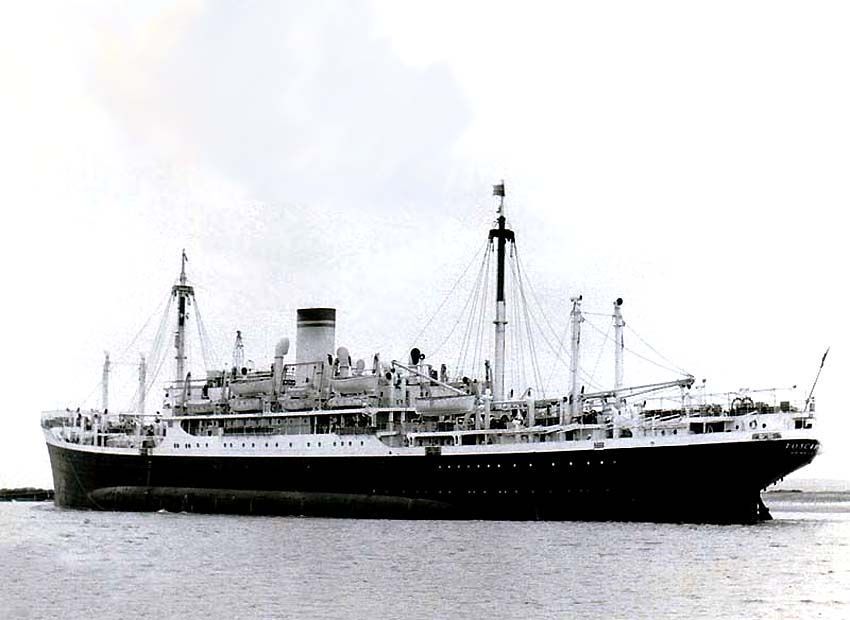
Photograph by
SS Toscana &
“The Rip” Incident in 1960:
On February 17,
1960 the SS Toscana whilst in
From the time of writing (2018) Fifty Eight years ago the Defence Force's suffered a major peacetime disaster, and yet for some reason there are hardly any Australians, or others around the world who have ever heard about this remarkable and sadly tragic as well an heroic story!
Who were the Men
Involved:
Some 75
young men of “2 Commando Company” and the
“Amphibious Platoon”, being the 1960s equivalent of the
today’s “Special Forces” serving today in
Afghanistan, headed out to sea on a regular night exercise using
inflatable Zodiacs and two-man kayaks as they had done in the
past. They were volunteer members of the “Citizen Military
Forces”, today they are known as the “Army
Reserve”. Like many young men in those days, they had
already done “Compulsory National Military Service” but
unlike the majority, these men were prepared to continue serving
their country in their own time.
These
men were extremely keen and they were very fit, as they had been
engaged for many weeks of training and ongoing military
exercises.
Details
of the
Their
special mission for that night of February 17, 1960 was to head
across “The Rip” which will be covered next.
On Sunday
February 17, 1960 it was a calm and balmy evening on Port Phillip
Bay, when a group of 75 commandos set off from Queenscliff on a
planned mock amphibious raid on the
The group
included members of the “Army Reserve detachment”,
which were integrated into the professional commandos.
As can
happen in the Bay, there was a sudden change in the weather,
which saw conditions become perilous beyond belief, with powerful
seas and massive waves of around metres.
Suddenly
the raiding craft, including the two men kayaks, zodiacs and
amphibious jeeps, were swamped, and men were rapidly washed into
the turbulent sea and the horrors of the night commenced.
SS
Toscana & Hero Private Roger Wood:
In this
turmoil, a zodiac with ten men aboard was swept out through the
Heads known as the infamous “The Rip” especially during
wild weather. These ten men were left hopelessly adrift for four
hours when they suddenly spotted a large ocean liner come along
using their searchlights. This passing passenger liner was the SS
Toscana, which was only alerted to their plight when the Army
Reserve member Private Joe Lamb, despite his fingers being numbed
with the extreme cold, had the presence of mind to fire his
point.303 loaded with blanks and fire off the international
distress call ‘SOS’.
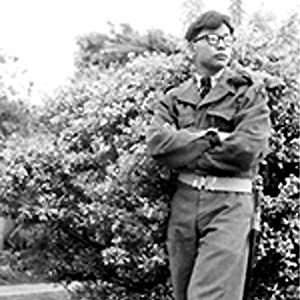
Photograph with
thanks to: www.haileybury.com.au/125years/125-years-of-stories/joe-lamb-and-the-rip-tragedy
Due to
the massive waves, the Toscana was unusually heaving violently in
the black turbulent seas, and apparently whilst in the bottom of
a wave, the commandos clinging tight to their zodiac could see
Toscana’s propellers exposed above sea level, and then
whilst on they were on the crest of a wave they drew level with
the deck of the liner, proving how wild the seas were.
Toscana’s
crew placed a rope boarding ladder and a number of rope lines
along the sides of aft part of the ship. One of the commandos, Private
Roger Wood, selflessly decided that he would take on the job of
assisting his fellow commandos up a rope ladder to safety. He did
this by holding onto the zodiac with one hand, and the rope
ladder with the other, trying to keep it as steady as possible
for his fellow companions to climb up to safety! Thus he
desperately clung to the wildly moving Zodiac with one hand and
the rope ladder with the other as one man at a time slowly
scrambled up the ladder onto the deck of the Toscana. But with
the stationary Toscana continuing to roll wildly in the huge
seas, and when the eight men from his Zodiac were finally safely
on the liner Roger was now just a few meters from safety.
Tragically
Private Roger Wood who was the last of the group to attempt to
board the ship, but as he let the zodiac go, his hand as well as
the one holding the rope ladder, were extremely painful. As he
attempted to climb up the ladder, with his weakened hands he was
fighting the brute force of the elements it was so much harder
for him than it had been for the others for the was no-one
holding the ladder and the zodiac steady. An Italian crew member
came down to assist Roger, but suddenly sea sprung up even bigger
again, and both of then were smashed wildly against the hull
which saw both Roger and the Italian sailor were flung with brute
force off the ladder by a huge wave. Somehow the crew member
managed just to keep hold of the end of the ladder and came back
onboard, but Roger was thrown far beyond the furious wild
“The Rip” and sadly Private Roger Wood was never seen
again.
There is
no doubt in my mind that Roger Wood was a hero, although I am
unable to locate anything whatsoever that he ever received a
posthumous recognition for his amazing bravery, for he only
thought of his mates on the Zodiac, and he gave his life by
saving them. What is wrong with the Australian Government and the
Army who denies a Reserve Member complete disregard of
recognizing a Reserve member for amazing Heroism!
Two Other
men Died that Night:
Two other
men also tragically died as they were swept out to sea during
this violent storm; they were Warrant Officer George
“Taffy” Drakopoulos and Eddie Meyer driver of the DUKW,
sadly both drowned before they were able to be rescued. The
aforementioned as well as Roger Wood all served their Country and
they all lived in the
Other
Craft on the Exercise & Rescue:
Some
of the other craft were thankfully not caught in “The
Rip” but the storm was made the waves huge no matter where
you were, and most vessels, kayaks and other craft capsized. Many
of the desperate men were picked up by their accompanying Duck
amphibious safety craft, only to then have a big landing craft
swamped and sunk. And so the unending night wore on.
Through
impossible visibility, a Queenscliff rescue craft including the
pilot boats battled the conditions for hours, searching for men
who were near death after treading water for hours in the
maelstrom. In incredible conditions that risked their own craft
and their crews, the local heroes picked up as many exhausted men
as they could find. Pilot George Simpson of the Akuna, was to be
awarded an MBE for his outstanding seamanship on that terrible
night.
On
Monday February 18, aircraft and boats went out at first light
for a long, final, but sadly a futile search.
Amazingly the military continue to operate special night exercises round around the same area regardless the sea conditions.
In Conclusion:
With
the Italian liner SS Toscana having picked up the eight men from
the Roger’s zodiac and a number of other men, she in due
course continued to
As it was stated; there was nothing to see this catastrophe coming and thus no one was blamed. An army court of inquiry later deemed it being a “misadventure”. Amazingly the military continues to operate special night exercises around the same area and “The Rip” regardless the sea conditions
Memorial
reads as follows;
There
is a small
The
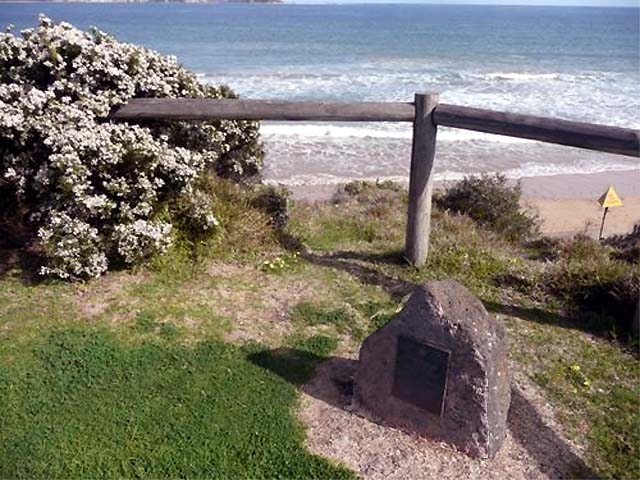
If you were
not looking for it, you would only stump your foot on it, for
sadly it is rather small
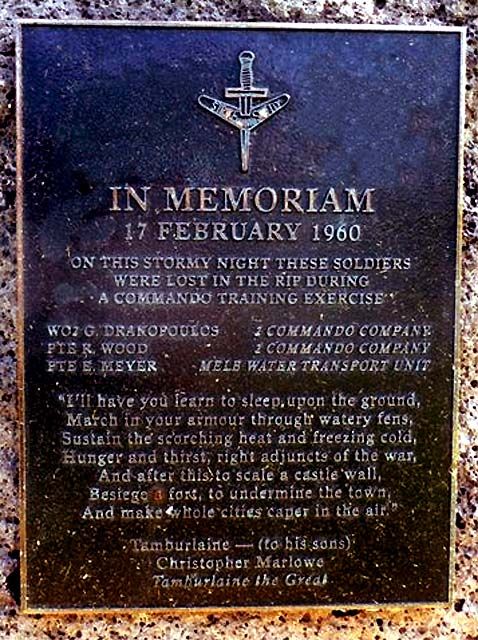
The Plague:
See below what it says …
IN
MEMORIAM.
17 FEBRUARY 1960.
ON THIS STORMY NIGHT THESE SOLDIERS
WERE LOST IN THE RIP DURING
A COMMANDO
TRAINING EXERCISE.
WO2
PTE R. Wood - 2 Commando Company
PTE
“I’ll have you learn to sleep upon the ground,
March in your armour through watery fews,
Sustain scorching heat and freezing cold,
Hunger and thirst, right adjuncts of the war,
And after this to scale a castle wall,
Besiege a fort, to undermine the town,
And make whole cities caper in the air”
************************
IN MEMORIAM.
February
17, 1960.
Warrant
Officer Class Two
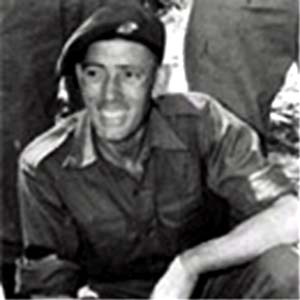
************************
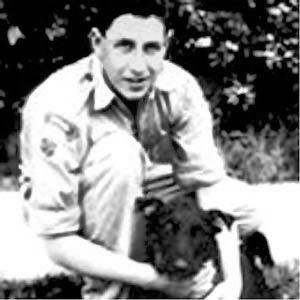
************************
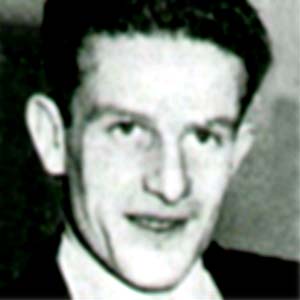
The
three photographs above have been obtained from www.commandotrust.com/honour-roll
Please Support the “Commando Welfare Trust” via ABN: 17 860 403 129
**********************
Page One
S.S. Toscana History.
Page Two
Family Shelling sailed on Toscana’s maiden voyage to
Page Three
*************************************
Other
MS Australia and Oceania & Neptunia
TN
Galileo & Marconi & MV Africa & Europa
*************************
“Blue Water Liners sailing to the distant shores.
I watched them come, I watched them go and I watched them die.”
Featuring over 1,365 Classic Passenger Liners, Passenger-Cargo Liners & Classic Cruise Ships!
Or ENTER HERE
For interest: Sadly an email service to
ssMaritime is no longer available, due to the author’s old
age and chronic illness as well as being disabled, etc. In the
past ssMaritime received well over 120 emails per day, but
*************************
ssMaritime.com
& ssMaritime.net
Where the
ships of the past make history & the 1914 built
The Author has been in Passenger Shipping & the Cruise Industry for well over 60 years
In addition he was the founder of “Save the Classic Liners Campaign” in 1990.
Please
Note: ssmaritime and associated sites are 100% non-commercial
and the author seeks no funding or favours of any shape
or form, never have and never will!
Photographs
on ssmaritime and associate pages are by; the author or
from the author’s private collection. In addition there are
some images that have been provided by Shipping Companies and
private photographers or collectors. Credit is given to all
contributors. However, there are some photographs provided to me
without details regarding the photographer/owner concerned.
This
notice covers all pages; although, and I have done my
best to ensure that all photographs are duly credited and
that this notice is displaced on each page, that is, when a page
is updated!
ssMaritime is
owned & © Copyright by